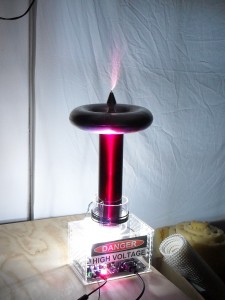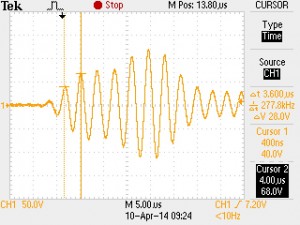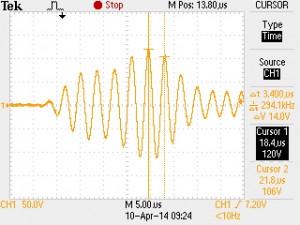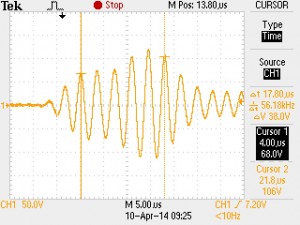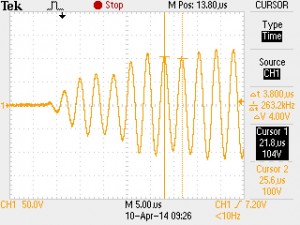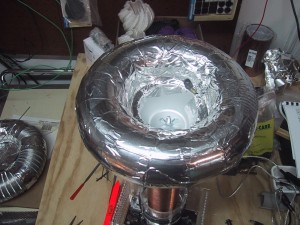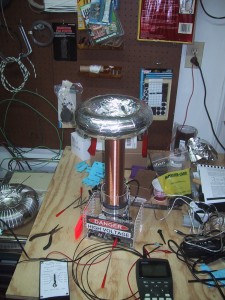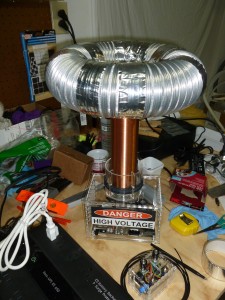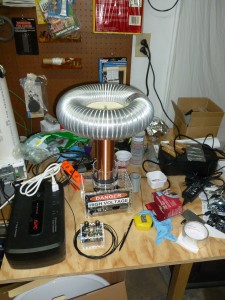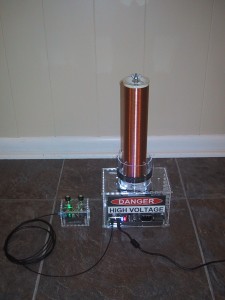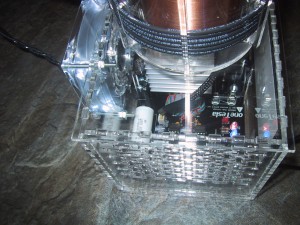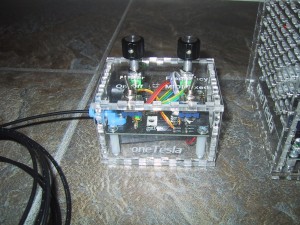Here is the coil with my custom top facing breakout point playing the Imperial March.
Tag Archives: oneTesla
OneTesla O-scope traces
I have reduced my primary to 5 turns, and using the standard 0.068 MFD tank cap, this is the general shape of my oneTesla output waveform (as captured by a scope probe hanging in the air about 3 feet away from the coil):

As you can see, the primary rings up and then the secondary oscillates for quite a while afterwards.
The next three traces are running the coil at a very low power level. Depending upon where I measure between peaks on the trace, I get different frequencies:
17.80 uS between five peaks, or 1 / (3.56 / 1000000) = 280 kHz
As the 280 is between the 277 and the 294, we’ll just say that my primary has a resonant frequency of 280 kHz, when at low power.
Next, I turned the power up a bit (around 1/3 of the way up) and got the following two measurements:
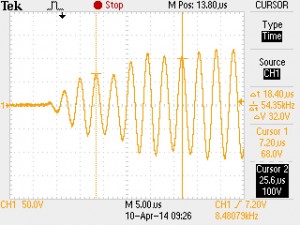
18.40 uS for 5 peaks, or 1 / (3.68 / 1000000) = 272 kHz
So my primary resonance is somewhere between 263 and 294 depending upon how I measure it, with a value of 272-280 looking to be a reasonable average.
Surprisingly, my secondary resonance measurements agreed with themselves a bit better. Here is the low power trace:
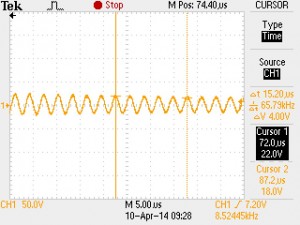
And the “Mid Power” trace.
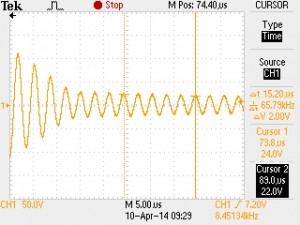
(You can see the primary ringing extending out so that it becomes visible in the trace…)
In both cases, I measured 15.20 uS between 5 peaks or
1 / (3.04 / 1000000) = 329 kHz
So my ratio is currently 329 / 280 or 1.175 ( Secondary 17-18% higher than my primary).
oneTesla top breakout point for my musical Tesla coil
Since I’ll be primarily using my oneTesla to play music, I wanted a top facing breakout (so the sparks will shoot up, instead of out to the side). Also, I wanted something more professional looking than a stick of metal taped to the top of the toroid. Here is the final product on the top of my toroid:
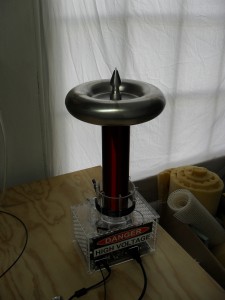
You can visit [ this post ] to see a video of it in action.
I used the lathe to get the general shape I wanted:
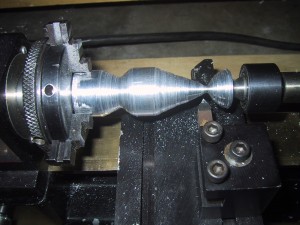
Then turned it to even up the 15 degree angle:
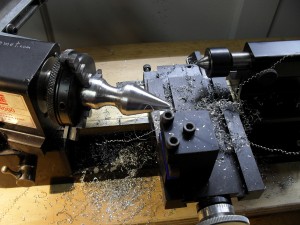
And this is my original 1″ diameter aluminum stock. I tapped it for the 14-20 bolt on the top of my Tesla coil that normally has a wing nut to hold the stamped toroid together, so the whole thing just screws onto the top.
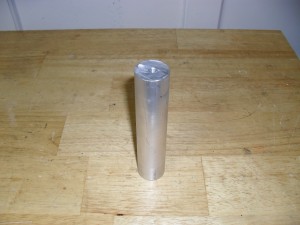
Building another Toroid
Since my first toroid was out of tune, I decided to actually follow directions this time and use an 8″ inner tube (2″ diameter) for my Toroid. I bought an 8″ inner tube and 50 yards of Aluminum Duct tape so I wouldn’t run out.
Then I went off-label and added a 4″ Big Daddio anodized aluminum personal pie pan which I’m going to try as a mounting system.
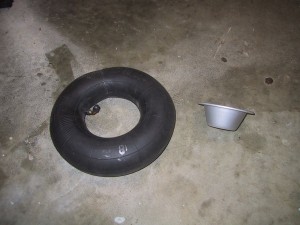
After drilling a hole in the base of the personal pie pan, I wrapped it and the inner tube with aluminum tape.
After this picture was taken I had to extend the aluminum tape down to cover the hole in the pie pan, as the anodized aluminum pie pan was apparently not conducting. After I did that I got less than 300 ohms resistance measurement from the outside of the toroid to ground.
The size of this toroid is much closer to spec, although the Big Daddio pie pan holds it about 1″ higher than a straight piece of cardboard. Unfortunately, when I measured it’s resonance, I found a big signal at 340 kHz, (2.93 micro-seconds) which is even higher than my first toroid! Obviously I’m doing something wrong.
Building a temporary toroid
I decided that I couldn’t wait for the official oneTesla stamped metal toroid to arrive, so I built one myself out of stuff I bought at the hardware store.
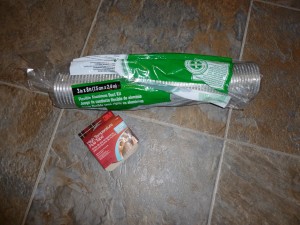
(Specifically 3″ flexible aluminum ducting, and aluminum Duct/Plumbers tape. I couldn’t find any 2″ flexible ducting…more about this later) I ran out of tape, so I couldn’t make it quite as nice as I would have liked, but a lack of tape isn’t my only problems from an aesthetic standpoint. I’m really looking forward to having the professionally stamped toroid, as it should maintain the great aesthetics of the kit.
It actually looked a lot nicer back when I only had one round of tape holding the two ends together. I also had some extra “Great Stuff” expanding foam that I had just used to plug some holes in the house, so I filled the inside of my toroid with some foam to give it a bit of extra rigidity before I taped it closed.
I used a piece of thin plywood to hold the toroid, and wrapped it in aluminum tape (until I ran out).
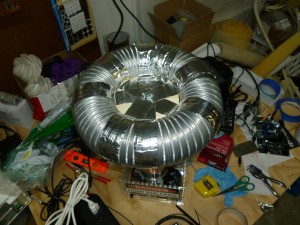
I used the last of my tape to completely cover the top and bottom of the wood circle and bridge to the toroid. I also taped the breakout point coming off of my toroid.
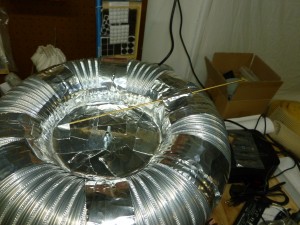
Now, for the big annoyance. Because I couldn’t find any 2″ tubing, I substituted 3″ tubing instead. The toroid has a major dimension of close to 11 inches and the diameter is 3″. The oneTesla recommended toroid has an 8″ major dimension and a 2″ minor dimension. I don’t know how much this will affect the Tesla coil, but I’m hoping that as long as I run it at 1/4 or 1/3 of the max power things won’t break.
Update:
Unfortunately, this toroid was measured about 70kHz out of tune (233kHz for the primary, vs 303khz for the toroid that I made). I only turned the power up to 40% and the primary oscillated, (you can hear the buzzing) but I never got a spark. I have a smaller 2″ diameter inner tube and more aluminum tape on order now…
oneTesla kit review and build comments.
Big Picture:
I was one of the first 100 backers of the oneTelsa Kickstarter (120 volt) and received one of their earlier kits (manual revision 1.3.0). Overall I was very happy with the kit. The overall build quality of the resulting Tesla coil (and especially the case) is much nicer than I could have achieved on my own without a kit, and the laser cut acrylic parts fit together very closely.
Because this is the first product the oneTesla team has shipped, and they are just starting out, some mistakes are expected. My kit did have one major problem: They accidentally shipped a 220 volt circuit board (for Europe or other countries that don’t use the 120 volt standard) and omitted the interrupter board entirely. Everything else in my bag of parts was set up for 120 volts. After a quick email to the oneTesla team they shipped me the correct circuit boards and I was able to solder them up. There were a few other minor hiccups with the kit (a missing screw, an extra fourth wire in the gate drive transformer pre-twisted wire set, weird reversed green LED’s, and a missing 2 pin jumper header that I replaced from my stock) but nothing else that was a real show stopper. The 1.3.0 manual was missing a few minor assembly steps, but nothing you couldn’t figure out from looking at the pictures and the parts lists, and most of those have been fixed in the 1.3.3 manual online.
Issues/suggestions for somebody else building a kit to think about:
Reversed Green LED’s
At least in the kit I received, the green LED’s were “backwards” in that the flat edge of the LED should be mounted OPPOSITE the flat edge in the circuit silkscreen. I believe they bought budget surplus gray market LED’s and got stuck with a batch with this weird manufacturing defect that a large company had rejected. This is documented in the errata online, and I didn’t make the mistake on the main board, but for some reason I didn’t remember to double check what color the LED was for the interrupter board. [Everything works with the LED reversed except you don’t get the power indication light ….but I decided it was worth fixing so that I didn’t accidentally run my battery down because I forgot to turn the interrupter off.]
Alternate Glue
They recommend using hot glue to affix all of the acrylic pieces. This would work, is somewhat reversible, and many people will already have a hot glue gun or can easily buy one locally. However, for the best visual appearance, I would recommend using acrylic welding solvent instead. Of course, acrylic welding solvent is scary stuff, so if you use it, read the warnings and wear nitrile gloves!
I used IPS Weld On 3 (McMaster Carr part number 7528A13) for both cases and the primary core base/clips. It will probably cost you as much as a hot glue gun to buy, but a one pint bottle will weld a LOT of acrylic. First, make sure you have the case assembled correctly, with all of the holes/slots lining up with the circuit board. Remember to try reversing the bottom piece if things are not lining up. Pay special attention to the slot where the wires from the primary core go into the screw terminals on the back. The cases are very nicely designed, but I wouldn’t have minded a few matching numbers etched in the corners to make it very easy to determine the exact orientation of each piece relative to one another.
After you are sure you have the cases assembled correctly (I held them together with rubber bands while testing), make sure that you can get your circuit boards into them from the top (they are a very tight fit, my case walls have to bend just slightly when inserting the main circuit board at an angle with a rolling motion).
To glue, lay the case down on it’s side with the base hanging off the edge of the table. (The base keeps the side pieces square.) Then use a q-tip to place a small drop of weld-on on the top of each tab that sticks up through the horizontal acrylic piece. You will see the water thin solvent wicking between the tabs and coating the bases of the joints between the tabs. I did one side (two sets of tabs) at a time with a ten minute wait between sides. Finally I turned the case upside down and affixed the base. Don’t glue on the tops!
For the primary core clips, I used clothespins to hold all six clips on. Make sure they are all straight and their spacing is evenly distributed. I used a coffee stir stick to place a small drop of acrylic welder on the top of the clip where it rests against the outside of the round acrylic primary form. After those set up (20 minutes) I took one clothespin off at a time and placed a drop of solvent on the top of the clip where it met the inside of the primary form, putting the clothespin back on to hold it in place for another 20 minutes. Finally, I turned the form upside down and placed a drop between the “U” bottom of the clip and the top of the form while rotating it slightly in my hand to use gravity to get the solvent to wick between the top of the form and the bottom of the clip’s “U”.
I did use hot glue to affix the top and bottom circles for the secondary core as that was an acrylic to ABS joint, which IPS Weld-On #3 isn’t good for, and it was a hidden joint anyways. I glued the bolt with magnet wire soldered to the terminal ring onto the acrylic circle while holding the bolt head in a pair of pliers, and used the wing nut to pull the bolt in tight. After the bolt was tight, I put extra hot glue all around the bolt head. Be sure to test your resistance between the bolts is less than 300 ohms (I got 228) before gluing the ends onto the secondary PVC pipe!
Battery in the interrupter
I was a little worried about the lack of clearance between the metallic case of the 9V battery and the bottom of the leads and solder connections on my interrupter board, so I wrapped the battery in black electrical tape to make sure nothing shorted out.
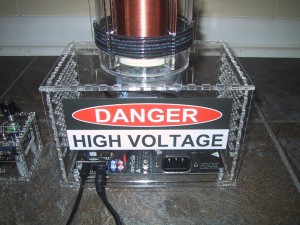
Terminal substitutions
I substituted a ring terminal for the fork terminal they provided in the kit for the ground wire that affixes to the bottom of the secondary bolt. I feel the ring terminal is less likely to accidentally come off. Their assembly pictures shows a ring terminal on their demonstration model while the manual notes that they provide a fork terminal.
Instead of soldering a wire to the ground terminal on the top of the IEC power inlet, I bent the terminal upright and then used a crimp-on female spade terminal on the end of the ground wire to connect the wire to the IEC ground clip. I don’t plan on removing this connection, but this gives me flexibility for alternate grounding solutions if I need it in the future. For example, I can remove the ground wire entirely and replace it with a ring terminal going to an exterior ground. (It was also easier than taking the circuit board out of my case to solder the wire on, or trying to navigate my soldering iron inside the case.)
oneTesla build
Who has a 99% complete tesla coil? Yes, that’s right, due to my extensive blogroll of the technorati (i.e. MIT students) I found out about the oneTesla kickstarter before it got super popular and got in on the ground floor (first 100 backers). Over the next month they got more and more interest, and I kept watching the features of the kit I had pledged/ordered go up. [Better interrupter, stamped toroid, etc…] Of course, like most kickstarters, it took them about three times longer than they had anticipated to actually ship the rewards, but I got my kit and (after a few customer service emails) put it all together!
The only thing missing is the stamped toroid for the top, so I can’t quite spit out long sparks to the tune of the imperial march, but since I was expecting to have to make my own toroid out of an inner-tube and aluminum tape when I made the pledge, I can’t complain about a few delays in such a custom component.
So until the toroid’s ship, you (and I) will just have to watch other people’s oneTeslas making music:
